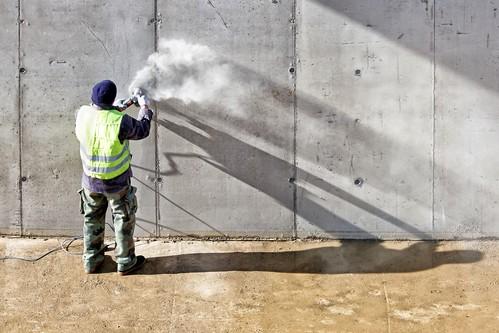
There are many ways to finish a concrete countertop, a concrete floor, or other objects. All these methods can make the concrete finish look classy and professional. Whether you’ve bought a precast concrete countertop or you’re adventurous enough to try and pour your own, you’re probably seeing tiny imperfections and wondering how to sand concrete.
Perhaps they’re not even visible to the naked eye, but running your hand over the surface reveals unnecessary roughness. Roughness that you want to be gone. So you’ve probably found yourself thinking: ‘How to smooth rough concrete?’
Depending on the intended look, it might be possible to sand it down by hand, grind it or you might require a specialist or a concrete polisher. Either way, read on to find out the method and tools needed, on how to sand concrete down to get the exact finish you want.
- Why Should You Sand Concrete?
- The Three Regular Concrete Finishes (with Photos)
- How to Polish a Concrete Countertop or a Concrete Floor
- Concrete Sanding FAQs
- Can You Sand Concrete?
- Can You Sand a Concrete Floor or Concrete Countertops?
- Which Tools Can You Use to Sand Concrete?
- Can You Sand Concrete with Regular Sandpaper?
- Can You Polish or Sand Concrete with Your Regular Sander or Grinder?
- How to Sand Concrete if It Is Stained?
- Why Should You Apply a Concrete Sealer or Stain?
- Bottom Line: Get a Smooth Finish for Concrete Surfaces
Why Should You Sand Concrete?
There are mainly 4 reasons why concrete should be sanded: Appearance, removal of imperfections, sanding down paint, stains or glue and repairs.
1) Appearance of the Surface
You will need to sand concrete to achieve one of the typical concrete finishes. If you have been using concrete around the house, this aesthetic aspect is probably one of the main reasons for sanding concrete surfaces. This is in particular true for concrete floors, walls, kitchen countertops, furniture made of concrete as well as other objects that are visible in your home.
2) Removing Sharp Edges and Protruding Aggregate
Even if you pour concrete thoroughly and work out the corners, sharp edges and protruding aggregates are likely to occur. You should remove these imperfections to avoid accidental injuries if someone touches that spot accidentally. If you have a concrete driveway, you might also consider the risk that sharp aggregates could damage your tires. Besides that, sanding such imperfections down enhances the overall look of the surface.
3) Removing Paint or Stains
If your surface has been stained or painted and neither cleaners nor paint strippers help you get rid of them, sanding is the last resort. This holds also true for the removal of glue. In this process, you will be removing the affected layer of your surface and thus restore the original look of the concrete.
4) Repairs
If concrete has cracked and needs repairs (e.g. with concrete crack fillers), you probably want to sand the entire surface to achieve a consistent touch and look. Note that the color of your filler might deviate from the original color of the concrete, so you might want to apply stain after the sanding.
The Three Regular Concrete Finishes (with Photos)
Smooth Finish
The simplest finish to achieve is a smooth finish. It can be done by hand, or with an orbital polisher. With this finish, you’re not removing any of the concrete. Just polishing the top layer to be smoother and shinier.
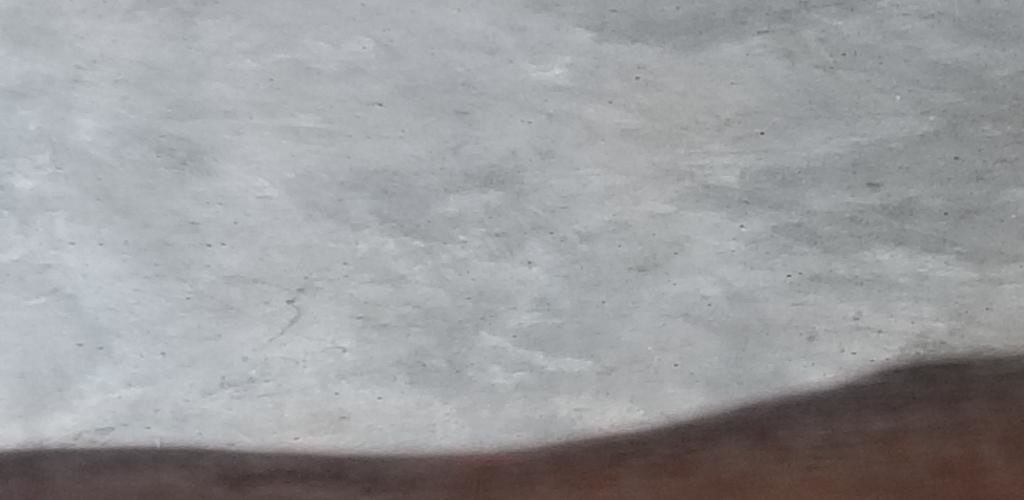
Salt and Pepper Finish
This is an intermediate finish where a small amount of the top layer is sanded off. Thus, the sand underlying the top layer is allowed to be exposed without revealing any aggregate.
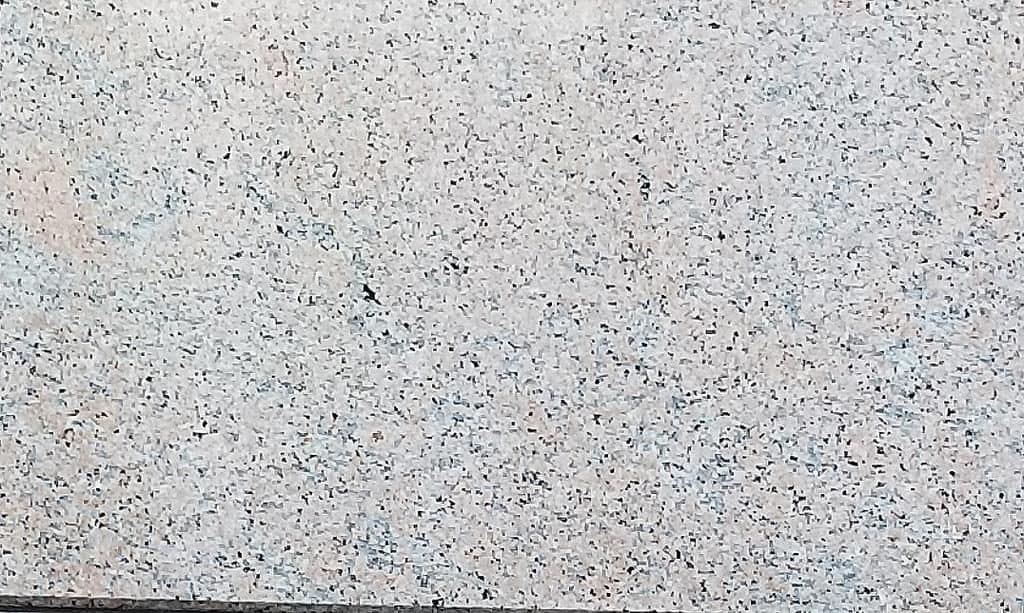
Exposed Aggregate Finish
This is a complete surface sanding, with a lot of material removed. Bear in mind, this finish is very difficult – if not impossible – to achieve without a powered polisher or sander.
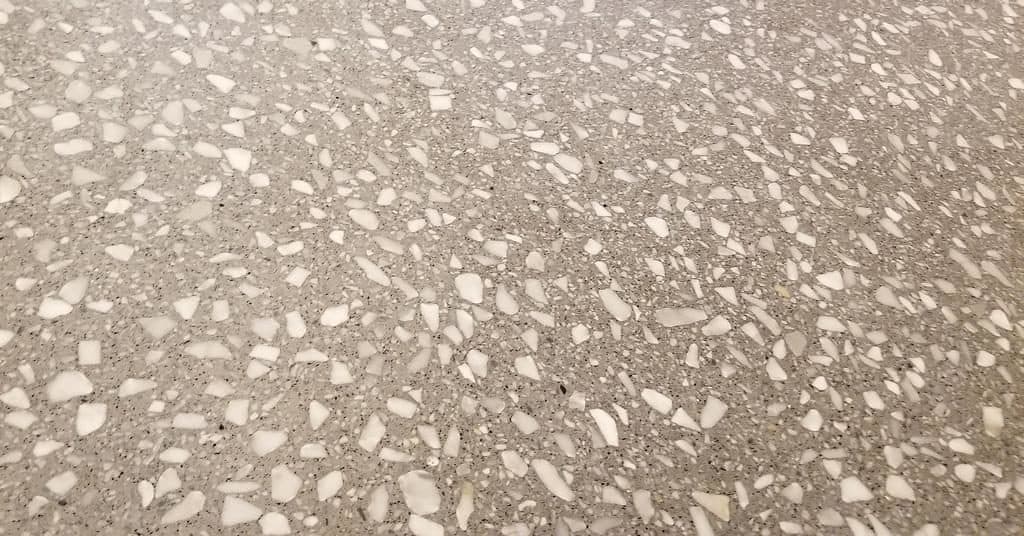
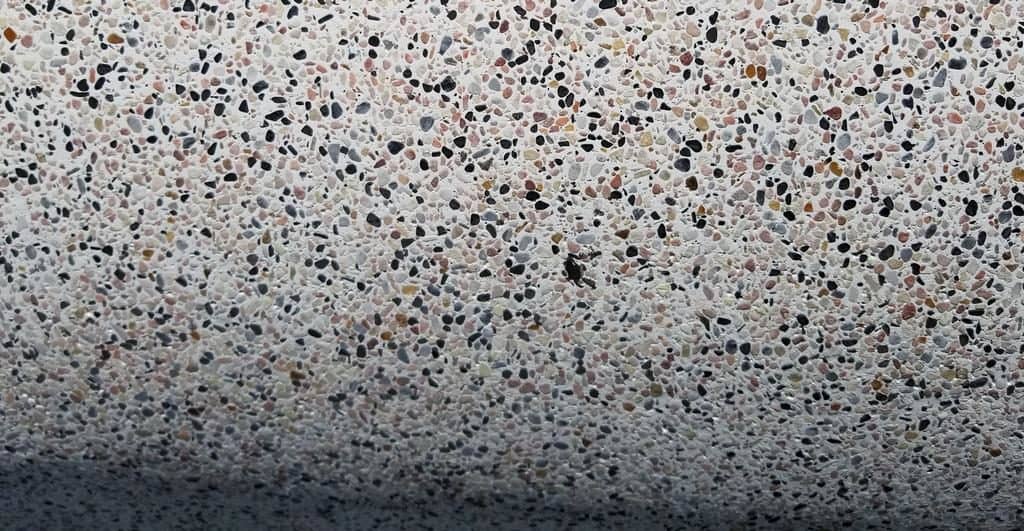
How to Polish a Concrete Countertop or a Concrete Floor
If possible, you should always sand and polish a concrete countertop, concrete floors inside the house as well as most other concrete objects. Not only does this improve the appearance of a surface, it will also go a long way in removing the tiny blemishes and flaws that come from even the most precise casting process.
While the following instructions focus on sanding countertops, you can use the same tools and equipment and follow the steps analogously when sanding a concrete floor or wall (read more in the following sections).
To sand and polish a concrete countertop, you will need (source):
- A variable speed concrete polisher, hand-held, and water fed with a variable speed setting (read our expert reviews of concrete sanders / polishers and compare current prices on Amazon).
- Diamond grinding pads, from fine to coarse (like these). Coarser pads are better at removing blemishes and exposing aggregates, with finer grits used for the final polishes.
- A squeegee
- Goggles, earplugs and, if you do dry-sanding, a mask
- Hand-held diamond pads or sanding pads for areas that you can’t get the polisher into.
How to Sand Concrete Countertops: The Method in 6 Steps.
Follow these 6 comprehensive steps to sand your concrete countertop. The time needed ranges from a few hours up to a day, depending on the size of the area.
The Damo DWP1257 Variable Speed Concrete Polisher
(check current price on Amazon)
1) Preparation
Clean the countertop with water, then run the squeegee over it closely to remove any grit or other particulates sitting on the surface. These can cause gouges as you sand it down.
2) Filling the Holes
Fill any flaws or holes with a patching slurry before polishing. Patching slurries are available in various colors to match or contrast against your countertop.
3) Polish the Surface
Begin by polishing with the coarsest pad you have. Make sure you cover the entire surface, for an even and smooth finish. Keep the polisher level, and make sure it’s supplied with a constant flow of water.
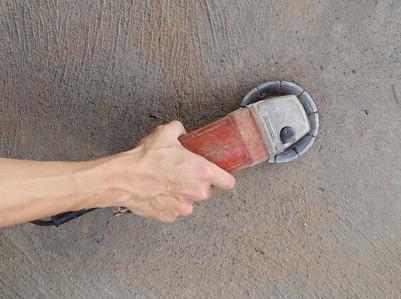
4) Polish the Surface with a Finer Pad
After polishing the whole countertop with your roughest pad, move up a step and polish it again. Repeat this process with every pad you have.
Between changing pads, it’s good to wipe over the countertop again to remove dust and other bits of debris. This is done to allow you a better view of your working area and to prevent imperfections from forming.
There is no hard and fast rule for how much you need to polish, or how long to use each individual grade of a pad. Use your judgment and err on the side of caution. You can always go back over a countertop, but repairing a concrete counter that has been over sanded is impossible.
If there are any areas that cannot be reached with a grinder, it’s time to start sanding concrete by hand. Using the pads, sand over the areas where they are needed with strong, smooth strokes, working upwards through coarseness as you did with the polisher.
5) Let It Dry
Once the countertop is dry and has the finish you desire, let it dry before applying a sealant to protect and seal your hard work.
6) Apply a Sealant
Apply a concrete sealant on the sanded concrete. It will help protect the surface from stains and other wear and tear.
Concrete sealants are easy to apply and protect and seal the surface.
Compare concrete sealants on Amazon.
Achieving a Uniform Look on Floors
Interior concrete floors can be sanded, but be aware that when you sand an interior concrete floor, you will have to use the same process over the entire surface of the floor, whether it needs it or not.
The reason for this is because sanding affects the surface of concrete and how far colors and staining can penetrate into it. So if you sand one section of a concrete floor, then stain the whole floor, the area that has been sanded down will be a noticeably different shade.
Concrete Sanding FAQs
Can You Sand Concrete?
Yes, concrete can be sanded in order to get a smooth and consistent surface. It is actually necessary if you want to achieve one of the three typical concrete finishes that are also introduced in this article.
Normally, large surfaces are sanded with hand-held or walk-behind concrete sanders or grinders. You can also use diamond sandpaper if it is a small or complex surface or if you prefer sanding concrete by hand.
Sanding concrete with a sander or grinder requires 6 steps that we are describing in detail in this article. It is usually done on a wet surface, so you will need a water supply (manually or as a built-in feature of your sander).
Can You Sand a Concrete Floor or Concrete Countertops?
You can basically sand any type of concrete surfaces, regardless of whether it is a countertop, a floor, a wall, or a decorative object. However, be aware that you will need the right tools for the job: you can sand small and comparatively smooth surfaces by hand with regular or diamond sandpaper. For larger objects, e.g. sanding a concrete floor or a wall, you should rather go for a power tool like a concrete sander or polisher (compare current prices on Amazon).
Which Tools Can You Use to Sand Concrete?
There are two groups of concrete sanding tools: hand-held concrete grinders/sanders and walk-behind sanders/polishers.
The hand-held tools are by far the most common ones among DIYers – they can be operated with both hands, used on all kinds of surfaces, including walls and even ceilings while being comparatively affordable. Read our comparison of such concrete grinders.
There are also hand-held grinders for harsh concrete work. Rather than polishing or smoothening a surface, they are used to remove layers of concrete. Therefore, they come with more power but often do not include water supply.
Walk-behind sanders are used for large concrete floors, some of them also for walls. These tools allow for doing this in an upright position, rather than requiring the operator to crawl on the floor. For DIYers, renting them can be a good option as they are rather expensive – while entry-level walk-behind polishers cost a high 3-digit amount, professional tools would set you back a few thousand dollars.
Can You Sand Concrete with Regular Sandpaper?
Yes. You can if you prefer to sand concrete by hand instead of using a power tool. Unfortunately, because concrete is so tough, regular sandpaper gets worn down very quickly against it.
You’re generally always better off spending a little extra for diamond sandpaper or diamond pads. It lasts much longer, and you’ll save yourself huge amounts of time and effort in the long run. You can find diamond sandpaper on Amazon.
Diamond pads are ideal for sanding concrete by hand (Amazon).
Can You Polish or Sand Concrete with Your Regular Sander or Grinder?
Whether you can use your sander or grinder on a concrete surface depends on the characteristics of your power tool: You can use it if it is aggressive enough for this hard material. However, regular palm and orbital sanders / grinders are usually made for softer materials and might not be powerful enough to cope with concrete.
There are special concrete polisher, grinder and sander available: They come with an amperage of at least 7 A (>= 800 Watt) while the amperage of palm sanders and grinders is usually between 1 and 4 A. These power tools are not cheap though. Read more about the different types of concrete grinders in our dedicated article.

The Bosch CSG15 Concrete Grinder/Sander – with 12.5 A, it is one of the most powerful hand-held concrete sanders on the market.
Check current deals on Amazon now.
How to Sand Concrete if It Is Stained?
If your concrete is stained, try cleaning it down before you sand and hope the stain comes out. Removing grease is especially important because grease can affect pigmentation and stop the staining color from penetrating fully into the concrete.
The best way to clean a concrete surface is with a mixture of 1 cup of trisodium phosphate (find it on Amazon) or 2 tablespoons of degreasing dish fluid with 4 gallons of water. Mix well and scrub the entire surface down with a stiff brush.
Once clean, rinse the surface down, then mop up and leave to dry or use a wet vacuum to remove the remaining water.
Why Should You Apply a Concrete Sealer or Stain?
Concrete sealer and stain fulfill two main purposes: supporting the strength of the concrete and providing a protective coat.
There is a broad range of different products available on the market, some concrete hardeners are even mixed into the cement paste before it is poured. However, only sealants, stain or paint add a protective coating to the surface.
Concrete sealants seal and protect a concrete surface (Amazon).
This layer prevents spilled liquids or water from soaking into the concrete and increases the water-resistance and general resilience of your concrete surface. Otherwise, even accidentally spilled red wine, for instance, could require a re-sanding of the entire surface to restore its perfect look.
Bottom Line: Get a Smooth Finish for Concrete Surfaces
Hopefully, now you understand how to sand concrete and know everything you need to achieve the perfect look in your home. With a little bit of care and attention, you’ll be able to get the exact finish that can set up any room. The best part is that you can do it all yourself.
Start today, read our expert reviews of concrete sander/polishers, rent or order your variable speed concrete polisher (check latest deals on Amazon) now and do not forget the diamond sandpaper (check prices on Amazon), if needed.
If you want to learn more about finishing concrete read also our article How to Grind Concrete.
Do you have any questions, or maybe any tips for our readers? Feel free to leave them in the comments below.





Tried the diamond sandpaper thing and it worked. Good tip guys
We had concrete work done at end of driveway. It was perfect however one area started with hairline cracks. We used a sealant on cracks but it makes the area look sloppy n very noticeable when it rains. Would sanding area lightly also remove the discolored areas from the section?
Hi Ann,
Thanks for your question. You might be able to remove the sealer if it’s only on the surface but this will also remove its protective effect – the cracks can become worse over time. To really fix it, you should consider sanding that area, repairing the cracks with concrete repair or crack filler (like these: https://amzn.to/34Ai62h) and applying a concrete sealer to the entire driveway.
Hope that’s helpful.
Chris